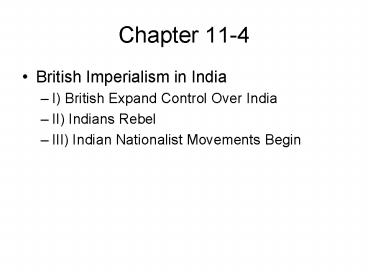British Imperialism in India - PowerPoint PPT Presentation
Title:
British Imperialism in India
Description:
Chapter 11-4 British Imperialism in India I) British Expand Control Over India II) Indians Rebel III) Indian Nationalist Movements Begin I) British Expand Control ... – PowerPoint PPT presentation
Number of Views:77
Avg rating:3.0/5.0
Title: British Imperialism in India
1
Chapter 11-4
- British Imperialism in India
- I) British Expand Control Over India
- II) Indians Rebel
- III) Indian Nationalist Movements Begin
2
I) British Expand Control Over India
- British economic interests began in the 1600s,
with the British East India Company setting up
trading posts - With the collapse of the Mughal Empire (1707),
The East India Company quickly took advantage to
seize control over most of India. - The company even had its own army led by British
officers and Indian soldiers (sepoys) - Britain considers India its primary colony (jewel
in the crown) because of its rich natural
resources and large population to serve as a
market for its goods.
3
I) British Expand Control Over India
- India both benefits and suffers under British
colonial rule - Benefits
- Large railroad system, large road network,
telephone and telegraph lines, dams, bridges and
irrigation canals enabled India to modernize - Sanitation and public health improved
- Schools and colleges were founded, literacy
improved - British put an end to bandits and local warfare
- Negatives
- British held all political and economic power
- Restricted Indian owned industries
- Switch to cash crops resulted in loss of self
sufficiency - British racist attitude threatened Indian
traditional life
4
II) Indians Rebel
- Many Indians objected to British control,
believing they were trying to convert them to
Christianity ansd the constant racist attitude
the British had. - Rumor of rifle cartridges sealed with beef and
pork fat offended both Hindus, who consider the
cow sacred, and Muslims, who do not eat pork. - This led to the Sepoy Mutiny, where soldiers
marched to Delhi and captured the city from the
British. - From there the uprising spreads north, but the
Indians were not able to unite against the
British due to the Hindu/Muslim split. - The British government stepped in by sending
troops and taking direct control of India from
the East India Company. - The part of India that was under direct British
rule was called the Raj (1757-1947), dividing
India into 11 provinces and some 250 districts.
5
III) Indian Nationalist Movement Begins
- In the early 1800s some Indians begin to demand
a greater role in governing themselves. - Ram Mohun Roy, sometimes called the Father of
Modern India speaks out against social
injustices such as caste separation, child
marriage and widow suicide. - Nationalists form the Indian National Congress
and the Muslim League which initially
concentrated on specific concerns for Indians,
but later broadened to a call for self
government. - A public outcry, including acts of terrorism,
forces Britain to redraw its partition of Bengal
into Hindu and Muslim sections.































